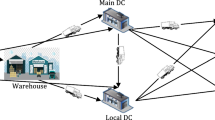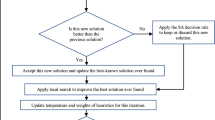Abstract
In this paper, we propose a two-phase approach to solve a combined routing and scheduling problem that occurs in the textile industry: fabrics are dyed by dye-jets and transported by forklifts. The objective is to minimize the cost of the unproductive activities, i.e., the dye-jet setup times and the forklift waiting time. The first phase solves an integer linear program to assign jobs (fabrics) to dye-jets while minimizing the setup cost; we compare an arc-based and a path-based formulation. The second phase uses a mixed-integer linear program for the dye-jet scheduling and both the routing and scheduling of forklifts. Experiments are performed on real data provided by a major multinational company, and larger test problems are randomly generated to assess the algorithm. The tests were conducted using Cplex 12.6.0 and a column generation solver. The numerical results show that our approach is efficient in terms of both solution quality and computational time.

Similar content being viewed by others
References
Brahmadeep, & Thomassey, S. (2014). A simulation based comparison: Manual and automatic distribution setup in a textile yarn rewinding unit of a yarn dyeing factory. Simulation Modelling Practice and Theory, 45, 80–90.
Bruno, G., Ghiani, G., & Improta, G. (2000). Dynamic positioning of idle automated guided vehicles. Journal of Intelligent Manufacturing, 11(2), 209–215.
Cho, E. (2004). Scheduling supply chains with batchwise fabric dyeing operations. Ph.D. thesis, North Carolina State University.
Confessore, G., Fabiano, M., & Liotta, G. (2011). A network flow based heuristic approach for optimizing AGV movements. Journal of Intelligent Manufacturing, 24(2), 405–419.
Desrosiers, J., Dumas, Y., Solomon, M. & Soumis, F. (1995). Time constrained routing and scheduling. In M. Ball, et al. (Eds.), Network Routing, Handbooks of Operations Research and Management Science (Chap. 2, Vol. 8, pp. 35–139). Elsevier Science B.V.
El Hachemi, N., Saddoune, M., El Hallaoui, I., & Rousseau, L.-M. (2013). Production scheduling and routing problem in the textile industry. In Industrial engineering and systems management (2013), Proceedings of international industrial engineering and systems management conference.
Felix, T., Chan, S., & Chan, H. K. (2004). A comprehensive survey and future trend of simulation study on FMS scheduling. Journal of Intelligent Manufacturing, 15(1), 87–102.
Giralt, G., & Chatila, R. (1987). Task programming and motion control for autonomous mobile robots in manufacturing. In IEEE international conference in robotics automation (1987).
Hao, G., Shang, J. S., & Vargas, L. G. (1996). A neural network model for the free-ranging AGV route-planning problem. Journal of Intelligent Manufacturing, 7(3), 217–227.
Hu, H., & Gu, D. (2000). Landmark-based navigation of industrial mobile robots. International Journal of Industry Robots, 27(6), 458–467.
Laoboonlur, P., Hodgson, T. J., & Thoney, K. A. (2006). Production scheduling in a knitted dyeing and finishing process. Journal of the Textile Institute, 97(5), 391–399.
Lin, L., Shinn, S. W., Gen, M., & Hwang, H. (2006). Network model and effective evolutionary approach for AGV dispatching in manufacturing system. Journal of Intelligent Manufacturing, 17(4), 465–477.
Maldonado, F., Ciurlizza, A., Radillo, R., & Ponce, E. (2000). Optimisation of the colour sequence in the dyeing process: Industrial applications. JSDC, 116, 359–362.
Morales, L., Maldonado, F., Radillo, R., & Ciurlizza, A. (1996). Optimisation of colour sequence in the process of fabric dyeing. JSDC, 112, 361–363.
Nara Lace Co., Ltd. (2003). Dye manufacturer chooses Asprova for high speed scheduling process and user-friendly GUI environment.
O’Kane, J. F. (2000). A knowledge-based system for reactive scheduling decision-making in FMS. Journal of Intelligent Manufacturing, 11(5), 461–474.
Saydam, C., & Cooper, W. D. (2002). A decision support system for scheduling jobs on multi-port dyeing machines. International Journal of Operations & Production Management, 22(9), 1054–1065.
Singh, N., Sarngadharan, P. V., & Pal, P. K. (2009). AGV scheduling for automated material distribution: A case study. Journal of Intelligent Manufacturing, 22(2), 219–228.
Toth, P., & Vigo, D. (2001). The vehicle routing problem. Philadelphia: Society for Industrial and Applied Mathematics.
Vis, I. F. A. (2006). Survey of research in the design and control of automated guided vehicle systems. European Journal of Operational Research, 170, 677–709.
Zhou, X., Chen, C., Wu, P., & Zheng, J. (2010). Optimized scheduling of production process based on continuous-time in printing and dyeing industry. CIESC Journal, 61(8), 1877–1881.
Author information
Authors and Affiliations
Corresponding author
Rights and permissions
About this article
Cite this article
El Hachemi, N., Saddoune, M., El Hallaoui, I. et al. A two-phase approach to solve the synchronized bin–forklift scheduling problem. J Intell Manuf 29, 651–657 (2018). https://doi.org/10.1007/s10845-015-1086-9
Received:
Accepted:
Published:
Issue Date:
DOI: https://doi.org/10.1007/s10845-015-1086-9




